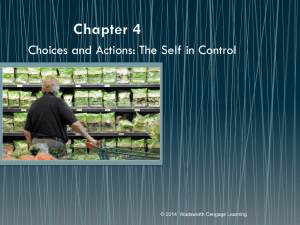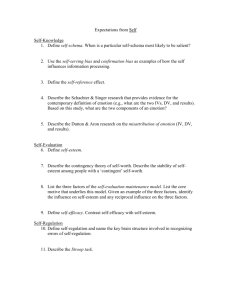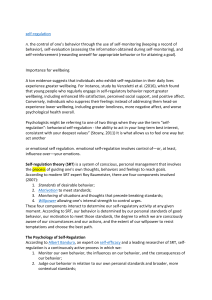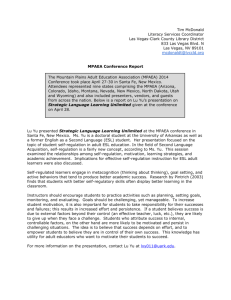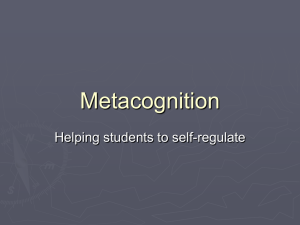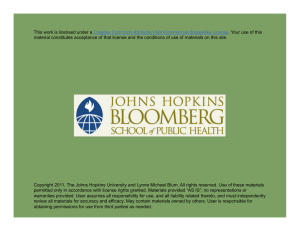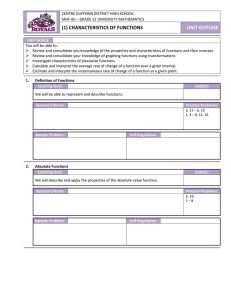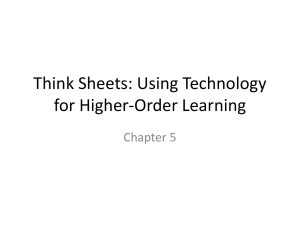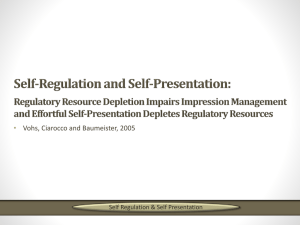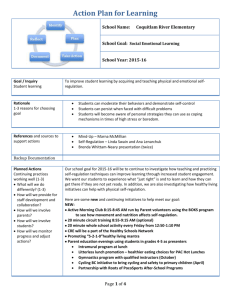Outline
advertisement
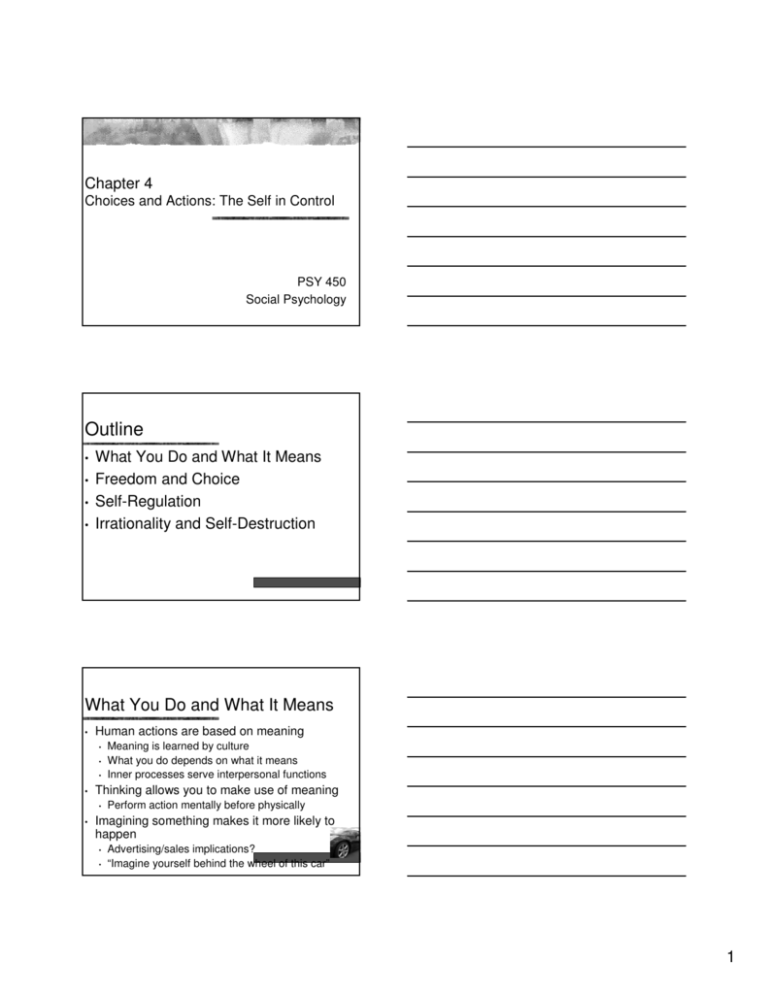
Chapter 4 Choices and Actions: The Self in Control PSY 450 Social Psychology Outline • • • • What You Do and What It Means Freedom and Choice Self-Regulation Irrationality and Self-Destruction What You Do and What It Means • Human actions are based on meaning • • • Meaning is learned by culture What you do depends on what it means Inner processes serve interpersonal functions • Thinking allows you to make use of meaning • Imagining something makes it more likely to happen • • • Perform action mentally before physically Advertising/sales implications? “Imagine yourself behind the wheel of this car” 1 Making Choices • We are bombarded with choices on a daily basis • • Example: 30,000 choices at the grocery store Two Steps of Choosing (Kahneman & Tversky, 1979) 1. 2. Narrow the range of options to a limited few Careful comparison of the remaining options • …but we are prone to biases, errors, and other influences Example: We tend to overestimate the impact of easily quantified features of decisions (e.g., salary) and neglect qualitative features (e.g., quality of life) Influences on Choice • Risk Aversion • • Temporal Discounting • • What happens right now often gets more weight than what might happen in the future (e.g., lottery winners usually take a lump sum payment right now for less total money) Certainty Effect • • People are more influenced by possible losses than gains (e.g., most people will not make a $10 bet on a coin flip) We place too much emphasis on certain features (e.g., the color and price of a car) and too little on uncertain features (e.g., potential repair costs and safety in case of an accident) Keeping Options Open • We often prefer to postpone hard decisions (e.g., students with a double major often divide their time and resources so they are not as successful in either major but they do this to keep their options open) Why Don’t People Choose? • Postponing decisions is part of a broader pattern called “Decision Avoidance” (Anderson, 2003) • • • • Status Quo Bias: Preference to keep things the way they are rather than change Omission Bias: Tendency to take whatever course of action does not require you to do anything (e.g., taking the default option) People tend to avoid making decisions in part because they worry about making the wrong decision (e.g., anticipated regret) Two broad reasons to delay making a decision (White, Reisen, & Hoffrage, 2008) • • None of the options seem good enough It is hard to tell which of the options is best 2 Reactance • Psychological Reactance: Our tendency to desire freedom of choice which results in a negative, aversive reaction to having some of our choices or options taken away by other people or external forces (e.g., negative feelings when our freedom is reduced) • Consequences of reactance: • • • • This is part of why we often postpone making decisions It makes you want the forbidden option more and/or makes it seem more attractive Motivates you to take steps reclaim the lost option (e.g., reasserting your freedom) You may feel or act aggressively toward the person who has restricted your freedom Choice and Change • • Do we have the freedom to change who we are? Individuals differ on whether they feel their traits are stable or changing • Entity theorists • • • Traits are stable Enjoy doing things at which they succeed Learned helplessness • • Belief that one’s actions cannot produce results (“Why bother?”) Incremental theorists • • • • Traits are malleable Enjoy learning, challenges Strive to improve performance Greater persistence Freedom of Action • Do we have free will? • Psychologists are divided on this issue • • • The belief in freedom of action is important • • If we explain behavior in terms of causes, then our behavior is not truly free On the other hand, if our behavior reflects choices, then we do have freedom When induced to reject their belief in free will, participants are more likely to cheat and steal (Vohs & Schooler, 2008) as well as behave more aggressively (Baumeister, Masciampo, & DeWall, in press) Perceived freedom is associated with… • • • Behavioral flexibility Controlled processes Self-regulation 3 Freedom of Action • More or Less Free • • Free Action Come From Inside • • We have the subjective experience of relative freedom (e.g., greater perceived choice in some situations than others) Self-Determination Theory (Deci & Ryan, 1985) is based on the idea that people tend to accomplish more and be more satisfied when they feel autonomous Having an Out vs. No Escape • Panic Button Effect: Believing that one has an escape option can reduce stress even if you never make use of the option Goals • Goals • • • Goals are influenced by inner processes and cultural factors • • • Ideas of some desired future state Link between values and action Typical individual has 15 goals (Little, 1989) May be conflicting or unrelated Setting and pursuing goals is a vital aspect of the self Goals • Setting goals • • • Choosing among possible goals Evaluating their feasibility and desirability Historical gender differences • e.g., women barred from certain professions, men discouraged as homemakers • Gender has less of an influence in modern society • Social factors often steer men and women towards different goals and jobs • Men more likely to take dangerous or unpleasant jobs for higher pay • Women more likely to choose jobs providing goal fulfillment and safety 4 Goals • Pursuing goals • Mindsets of setting and pursuing goals differ • Planning and carrying out behaviors to reach goals Goal Setting Goal Pursuit Function Deciding what to do Deciding how to do it…and doing it Attitude Open-minded Closed-minded Mental Focus Feasibility and desirability Means and obstacles Core Question Why should I do it? How do I do it? Style of Thought Realistic thinking Optimistic thinking Goals • Conscious and automatic systems help pursue goals • Conscious system • • • • Sets goals Resume activity after interruption Devise alternative plans Automatic system reminds us of unmet goals • Zeigarnik effect • • A tendency to experience obtrusive thoughts about a goal whose pursuit has been interrupted Ex. Turning the radio off in the middle of a song may lead to the song being stuck in your head for the rest of the day Hierarchy of Goals • Short-term (proximal) and long-term (distal) • Automatic system helps keep track of goals • • • Short-term goals are like stepping stones Conscious system is useful if an intermediate goal is blocked Goal shielding refers to shutting out thoughts of competing goals at certain times (e.g., not thinking about your goal of finding a spouse while you are studying for an exam) 5 Plans • Planning • • • • Focus attention on reaching goal Specific guidelines on what to do Motivate people to work on goals Specific plans can help • …but plans that are too detailed or rigid can be discouraging • • e.g., construction projects often run late and over budget Plans tend to be overly optimistic • Overly optimistic plans • • Planning fallacy is believing that your plan will proceed as planned while knowing that most plans do not (Kahneman & Tversky, 1979) Future versus short-term plans • • Unrealistic optimism more likely when goal is far into the future Example: it is easy to be overly optimistic about an exam that is a month away…but that changes as the exam gets closer Self-Regulation • Self-regulation (self-control) • • • • The capacity of the self to alter its own responses Enables humans to live in culture and adapt to new circumstances Important factor for success in many areas of human life Effective self-regulation relies on • • • Standards Monitoring Self-Regulatory Strength Standards • Standards • • • • Ideas of how things could be Provided by culture Both what to do and what not to do Regulation means changing to bring into line with some standard • • Effective self-regulation requires clear and well-defined standards Ambiguous, uncertain, inconsistent, or conflicting standards make self-regulation difficult 6 Monitoring • Monitoring • • • Keeping track of behaviors Self-awareness allows us to monitor TOTE is the self-regulation feedback loop of Test, Operate, Test, Exit • • • • Test: Compare self to standard • If discrepancy, move to next phase Operate: Make conscious effort to change Test: Compare self to standard again • If standard still not met, go back a step Exit: If standard met, exit loop Self-Regulatory Strength • Capacity for change (willpower) • • Active phase of self-regulation Willpower can be depleted • • • Resisting temptation uses up willpower e.g., Hungry students were asked to eat radishes in the presence of freshly baked cookies or were allowed to eat the cookies (Baumeister et al., 1998) • Later, those who ate the radishes did not persist as long on difficult puzzles With practice, self-regulatory abilities can be strengthened • Muscle analogy Dieting • • Dieting is a form of self-regulation that requires an override of the natural response to eat Commitment to standards • • • Monitoring • • • • Goal for weight loss (e.g., target body weight) Helpful to have short-term and long-term goals Keeping track of eating behavior and weight When diets are broken, individuals often binge Food intake should be constantly monitored and weight should be measured daily (Wing, Tate, Gorin, Raynor, Fava, & Machan, 2007) Willpower or the capacity to change • This capacity can be drained by other aspects of life (e.g., stress at work or in your relationship) 7 Irrationality and Self-Destruction • Self-defeating behavior • Any action by which people bring failure, suffering, or misfortune on themselves Paradoxical • Rational beings acting irrationally • • • • Does not make logical sense e.g., Smoking, risky sexual practices, gambling, etc. People almost never directly seek failure, suffering, or misfortune • • • Freud suggested that people have a ‘death drive’ Another theory (Horner, 1972) suggests that women may have a fear of success Research has shown that both of these theories are wrong Self-Defeating Acts • Self-defeating acts result from • Self-defeating Tradeoffs • • Accepting a negative outcome to gain a positive outcome Frequent when reward is immediate and the cost is delayed • • Faulty knowledge and strategies • • Example: Smoking • Positive outcome: instant stress relief • Delayed cost: lung cancer “I do my best work under pressure” Overemphasize the present rather than the future Tradeoffs - Now Versus Tomorrow: Delay of Gratification • Capacity to delay gratification • Ability to make immediate sacrifices for later rewards • • Mischel and colleagues studied this in children • They put a desirable treat in front of the child (cookie, marshmallow) and told that if they waited for the experimenter to return, rather than summoning them with a bell, they would get a larger treat • Some children were able to wait, some could not • Marshmallow Test Video Children able to delay gratification at 4 years old tended to be more successful adults 8 Suicide • • • The ultimate in self-destructive behavior Often involves tradeoffs Fits the now-versus-future pattern • • • Willing to trade away future to end present suffering Individuals who commit suicide were often highly self-aware One theory cannot account for all suicides • Individuals have other reasons to commit suicide such as the reasons held by suicide bombers Conclusion • Humans have an elaborate inner system for controlling behavior • • • • • Make choices in novel ways Link here-and-now with distant realities Use complex reasoning processes Better developed self-regulation Capacity for self-destructive behavior 9
